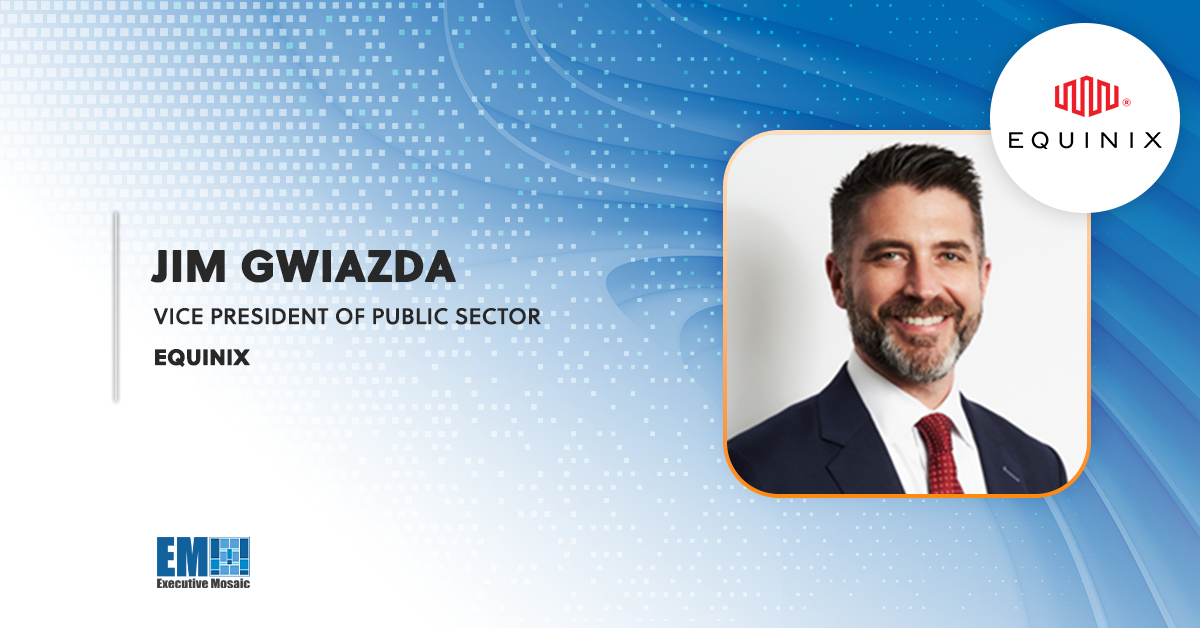Artificial intelligence is unlocking new opportunities for federal agencies and government contractors. But what does an AI-powered future look like? Jim Gwiazda, vice president of public sector at Equinix, sat down recently with Executive Mosaic to answer this question.
Gwiazda joined Equinix at the end of 2022 from MetTel. His career also includes more than two decades with AT&T and over 12 years of service with the U.S. Army Reserve.
Read the full Executive Spotlight interview with Jim Gwiazda below.
Tell me about the current state of the artificial intelligence market. Where are you seeing new opportunities in AI, and where do you think the market is heading?
Broadly speaking, the market is experiencing significant growth. In many cases, the demand is exceeding the supply for not only the chips to support AI but also the physical space and power to handle the massive workloads the technology brings. This is causing an unprecedented level of investment within the private sector to keep pace with the current and perceived future demands. It’s clear, based on the administration’s actions and the work that’s underway, that agencies recognize the potential of AI to enhance efficiency, improve decision-making and how the use of this technology will better serve the interests and security of our nation.
In terms of where it’s heading, I don’t think anyone can really know that with any level of certainty. However, looking at the Federal AI Use Case Inventory gives us a glimpse into how agencies are looking to leverage AI to serve the best interests of the public, from benefits delivery, transportation and healthcare to the environment.
Across the board, we’re seeing AI being utilized to enhance intelligence analysis, cybersecurity, autonomous systems and predictive analytics for threat detection. Within healthcare, some interesting use cases involve improving medical diagnostics, drug discovery, patient monitoring and healthcare management systems. Another great use case is for data analytics, using AI to analyze large volumes of data, extract insights and support evidence-based decision-making across various agencies.
A few areas of opportunity include ethical AI and cross agency collaboration. Ethical considerations, transparency and accountability in AI systems are gaining importance and need to be at the center of any AI discussion. While the administration is focusing on developing policies and regulations to ensure responsible AI use, privacy protection and fairness, which is a start, more work remains. In terms of collaboration, there is active interest and investment in public private partnerships, AI research and development and a growing emphasis on collaboration between and across agencies, academia and industry to accelerate AI adoption.
In which applications are you seeing the highest demand for AI/ML from your federal customers, and can you explain what’s driving that demand?
Some of the areas where we are witnessing the highest demand are predictive analytics, natural language processing, image and video analysis and of course, cybersecurity. There are a whole host of drivers, such as automating repetitive tasks to free up and allocate resources more effectively. In addition, I believe AI/ML will be a game changer for agency knowledge workers. The insights that can be gleaned from AI will significantly enhance data-driven decision-making. Another area worth mentioning is the improvement in the access and delivery of citizen services. As we continue to move towards a more robust self-service citizen centric environment, AI/ML will aid in providing personalized experiences, faster response times and more efficient interactions with agencies.
Generative AI has been the source of a major AI boom in the last year, but some of these tools are also proving to be risky. How do you think cybersecurity will have to evolve to stay ahead of potential threats posed by AI tools?
I’ll preface this by stating upfront that I am far from a cybersecurity expert. However, there are three areas that come to mind that warrant continued discussion: adversarial machine learning, AI-powered threat detection and cross-agency collaboration and information sharing. The number of and level of sophistication from bad actors are growing daily. How we respond to and withstand attacks on our AI systems to ensure the integrity and reliability of AI-generated outputs is critical.
Which other emerging technologies do you anticipate will have the greatest impact on the federal landscape in the next few years?
While not necessarily emerging technologies, over the next few years, I believe edge computing, quantum computing and private AI will have a meaningful impact across the federal landscape. With edge computing, we will see even faster data analysis and reduced latency to support real-time decision-making, whether it’s to support autonomous vehicles on our roads and highways or to support warfighters in forward-deployed areas. Advancements in quantum computing will have implications for cryptography, optimization, simulation and data analysis, enabling breakthroughs in areas such as national security and scientific research. And perhaps a lesser-known emerging technology that is a subset of AI, private AI will be part of every agency’s AI strategy. Private AI enables agencies to maintain control over their high-value sensitive data, offering advantages in terms of privacy, predictability and performance.
These emerging technologies have the potential to reshape the federal landscape by enhancing capabilities, improving efficiency and addressing complex challenges at the speed of the mission. The successful adoption and integration of these technologies will require strategic planning, investment and collaboration between government agencies, industry partners and academia.



